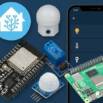
[100% Off] Building Smart Home Automation Solutions With Home Assistant
Configure, integrate, and manage hardware and software system to automate your home
What you’ll learn
- Understand home automation fundamentals
- Set up Home Assistant on Raspberry Pi
- Create and integrate IoT devices: Build sensors and actuators using ESP8266/ESP32 and connect them to Home Assistant.
- Use tools like Node-RED
- InfluxDB
- and Grafana to visualize data and create intelligent automations.
- Explore real-world projects: Implement hands-on solutions like LED strip controllers and multi-zone temperature loggers.
- – Stay ahead with emerging trends: – Gain insights into the future of smart home tech and how to keep evolving your setup.
Requirements
- Understanding sensors
- actuators
- and microcontrollers like ESP8266/ESP32 will be a big plus.
- – Knowing how to set up and work with Raspberry Pi hardware and OS will help you hit the ground running. –
- Be familarize or experiencing or coding is a big plus.
- A grasp of IP addresses
- MQTT
- and local network setups will help you integrate devices effectively.
Description
This hands-on course empowers learners to design and deploy intelligent home automation systems using Home Assistant, an open-source platform that integrates seamlessly with ESP32 microcontrollers, Smart Switch, sensors and actuators. Participants will explore the fundamentals of smart home architecture, IoT protocols, and device communication, then dive into practical implementation using Tasmota and ESPHome firmware.Through guided modules, students will learn to flash and configure ESP32 boards, connect sensors and actuators, and build responsive automations using MQTT and native APIs. The course emphasizes real-world applications—such as motion-triggered lighting, temperature-based fan control, and voice-activated scenes—while reinforcing best practices in security, remote access, and system reliability.
Learners will also gain experience customizing dashboards, integrating voice assistants like Google Assistant or Alexa, and managing smart devices through intuitive interfaces. By the end of the course, participants will complete a capstone project showcasing a fully functional smart home solution tailored to their environment.Ideal for technical students, educators, and professionals in electronics or automation, this course bridges theory and practice to unlock the full potential of modern home automation. No prior experience with Home Assistant is required, but basic knowledge of electronics and networking is recommended.
Primary Learning Outcomes
-
Smart Home Fundamentals
-
Understand the architecture of smart home systems
-
Learn key IoT protocols (MQTT, Wi-Fi, API integrations)
-
Explore centralized vs decentralized automation models
-
-
Home Assistant Setup & Configuration
-
Install and configure Home Assistant on Raspberry Pi or virtual machine
-
Navigate the UI, manage entities, and use YAML for automation
-
Set up add-ons like MQTT broker and ESPHome dashboard
-
-
ESP32 Device Integration
-
Flash ESP32 boards with Tasmota and ESPHome
-
Connect sensors (e.g., DHT22, PIR) and actuators (e.g., relays)
-
Integrate devices with Home Assistant via MQTT or native API
-
-
Automation & Control Logic
-
Build automations using triggers, conditions, and actions
-
Use templates and scripts for advanced logic
-
Create scenes and schedules for smart behavior
-
-
User Interface & Voice Control
-
Customize Lovelace dashboards for mobile and desktop
-
-
Security & Remote Access
-
Secure Home Assistant with HTTPS and user roles
-
Enable remote access using DuckDNS or Nabu Casa
-








